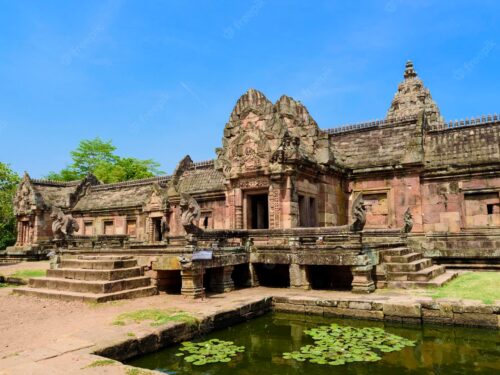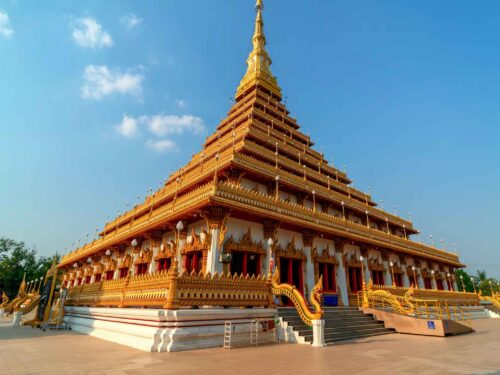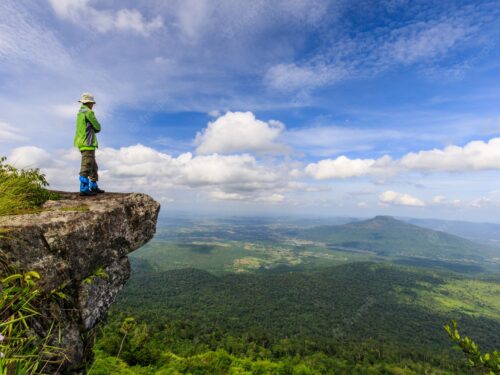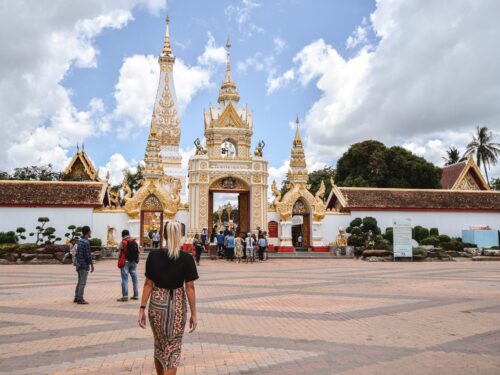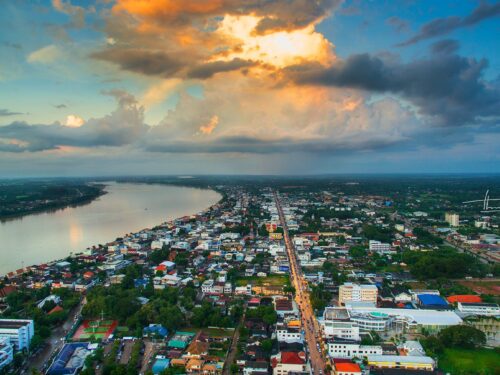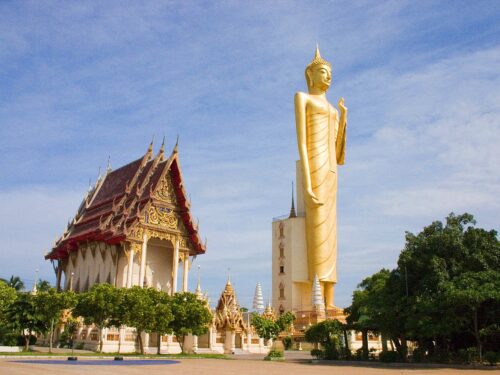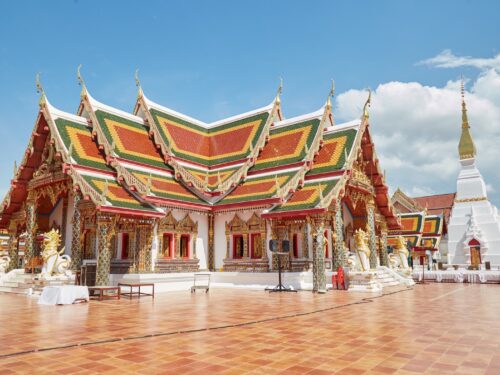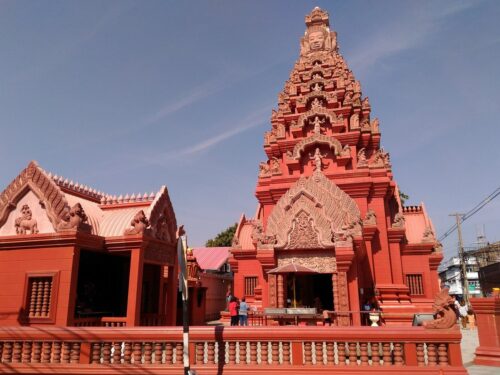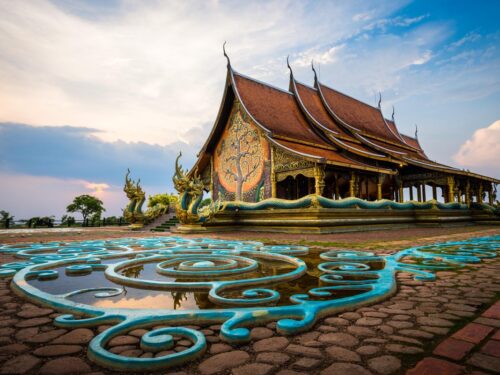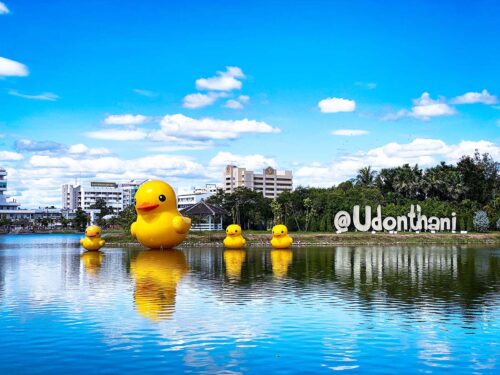Nakhon Ratchasima
Nakhon Ratchasima, generally known as “Khorat”, is Thailand’s largest province situated on sprawling northeast plateau. Located approximately 260 kilometers northeast of Bangkok, the city itself serves as the gateway to the lower northeastern region.
Covering an area of 25,494 square kilometers that is mainly plateaus and mountainous terrain, Khorat has fascinating traditions, charming hospitality, splendid natural scenery and awesome historical sites.
Some of the main attractions in Khorat are Khmer ruins. Scattered around the province, these products of ancient wisdom shines through time. One of the Thailand’s finest Khmer ruins can be seen here next to Mon and Lao sites. In addition, Khorat has an abundance of natural attractions in its forests, hills, wildlife and waterfalls that are easily accessible in locations such as Khao Yai National Park.
Apart from the famous statue of Khun Ying Mo, Khorat is most well known for silk weaving (in Pak Thong Chai) and a variety of top-notch quality handicrafts such as clay pottery products of Dan Kwian.
Geographically, Nakhon Ratchasima borders on Chiyaphum and Khon Kaen Provinces in the north, Buriram Province in the east, Chiyaphum and Saraburi Provinces in the west and Nakhon Nayok and Prachin Buri Provinces in the south.
Khorat is also the largest northeastern province. Inhabitants of the province are mainly engaged in agricultural activities that include farming of rice and other crops such as sugar cane, tapioca, corn, jute, peanuts, sesame and fruits. There are more than 100 savings and agricultural cooperatives in the province, 35 irrigation projects and 7,122 industrial factories. Most of the factories are rice mills, tapioca product manufacturers, and industrial factories.
Khorat’s most popular annual event is the Thao Suranari Festival, a celebration of Thao Suranari’s victory over the Lao. It’s held from late March to early April and features parades.
How to go to Nakhon Ratchasima
By Car
– Route 1: Take Highway No. 1 (Phahon Yothin) from Bangkok to Saraburi and then take Highway No. 2 (Mitraparp Highway) from Saraburi to Nakhon Ratchasima. The total distance is 259 kilometers.
– Route 2: Take Highway No. 304 from Bangkok and proceed past Min Buri, Chachoengsao, Phanom Sarakham, Kabin Buri, Pak Thong Chai, to Nakhon Ratchasima. The total distance is 273 kilometers.
– Route 3: Take the Bangkok-Rangsit-Nakhon Nayok route then take Highway No. 33 to Kabin Buri and Highway No. 304 past Wang Nam Khiao, Pak Thong Chai to Nakhon Ratchasima.
By Bus
Ordinary buses leave the Northern Bus Terminal (Mochit 2 Bus Terminal) in Bangkok every 15 or 20 minutes from 5 a.m. to 10.15 p.m. Air-conditioned buses leaving for Bangkok arrive and depart from the Korat’s air-conditioned bus terminal on Mitraparp Highway.
The Transport Co., Ltd. (known as Bo Kho So) has both air-conditioned and non air-conditioned buses departing from the Bangkoks Northern Bus Terminal (Mo Chit 2 Bus Terminal) daily. Air-conditioned buses depart from Bangkok every 10 minutes all day, traveling time is 3.20 hours and the fare is 157 baht. Non air-conditioned buses depart from Bangkok every hour from 5 a.m. to 8 p.m., traveling time is 4.30 hours and the fare is 87 baht. For information, call 0 2936 2852-66 or get more updated information at www.traco.motc.go.th.
Private companies that offer bus services are Ratchasima Tour Co., tel. 0 4424 5443, Bangkok tel. 0 2936 1615 and Air Khorat Co., tel. 0 4425 2999, Bangkok tel. 0 2936 2252.
Buses running to other provinces leave from Bus Terminal 2 in Khorat. There are services to the northeastern provinces of Chaiyaphum, Khon Kaen, Udon Thani, Nong Khai, Nakhon Phanom, Sakon Nakhon, Kalasin, Ubon Ratchathani, Buri Ram (the old route goes past Nang Rong and the new one past Huai Thalaeng), and Surin (past Nang Rong-Ban Tako). In addition, there are buses to Bangkok, Chon Buri, Pattaya, Rayong, Chanthaburi, Lop Buri, Sing Buri, Nakhon Sawan, Chiang Mai, and Chiang Rai (up to Mae Sai). All depart from the Bus Terminal 2 in Khorat.
Getting around Korat
Traveling within the province is easy, with many mini-bus and bus routes operating in the city and nearby areas. The fare on each route is 3 baht. Comfortable air-conditioned bus services are also provided for route No. 2 at the rate of 5 baht.
A more convenient way to get around is to take the Tuk-Tuk or Samlor in the city. Samlors around the city costs 20 baht; while tuk-tuks cost 40 baht to most places around town (30 baht for a short hop) and 50 to 60 baht for longer trips. The rate for motorbike taxis is within the same range. Please note that the price must be agreed upon before a trip.
If traveling to another district, it is possible to take either a bus or mini-bus at Bus Terminal 1 on Burin Road. At Bus Terminal 2, only provides bus services to Amphoe Phimai and Dan Kwian-Chok Chai.
For information, call Bus Terminal 1 on Burin Road, tel. 0 4424 2899 and 0 4426 8899 and Bus Terminal 2 on the Mitraparp-Khon Kaen Road, tel. 0 4425 6006-9 ext. 175, 176 (air-conditioned), 178 (regular).
By Train
An express train bound for Ubon Ratchathani departs Bangkok’s Hualamphong Station at 9 p.m. and arrives in Khorat at 2.03 a.m.
Rapid trains on the Ubon railway depart at 6.50 a.m., 6.45 p.m. and 10.45 p.m., arriving in Khorat at 11.48 a.m. and 11.51 p.m. and 4.07 a.m. respectively. especially the morning arrival, which leaves plenty of daylight time to explore the city.
There are also two ordinary trains (3rd class only) that depart Bangkok at 3.25 and 11.25 p.m., arriving in Khorat about 5 1/2 to 6 hours after departure.
The 1st class fare (express train only) is 230 baht, while the 2nd class and 3rd class fares are 115 baht and 50 baht respectively. An additional fee of 40 baht is charged for rapid trains, 60 baht for the express and 80 baht for the special express train. The train passes through some great scenery on the Khorat Plateau, including a view of the enormous white Buddha figure at Wat Theppitak on a thickly forested hillside. Visit www.railway.co.th or call 1690 for more up-to-date schedules and fares.

